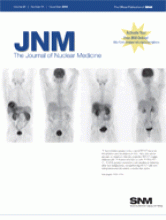Apoptosis imaging: Niu and Chen look beyond annexin V at alternative techniques for visualization of cell death, including approaches that build on phosphatidylserine externalization, activity of caspases, and mitochondrial membrane potential Page 1659

Response to hormonal stimulation: Linden and Mankoff comment on the question of whether glycolysis may be a valid early marker of response to hormonal stimulation therapy in breast cancer and preview a paper on this topic in this issue of JNMPage 1663
Effects of health economics: Hicks and Borland provide commentary and perspective on the sometimes contentious relationships among the clinical community?, health care funding bodies, and formalized health technology assessments Page 1665
Cost and PET/CT in NSCLC: Schreyögg and colleagues report on the cost-effectiveness of staging non–small cell lung cancer with CT alone and with integrated PET/CT in German clinical practice Page 1668
PET/CT and MRI in prostate cancer: Jambor and colleagues use qualitative and quantitative approaches to assess the ability of 11C-acetate PET/CT, MRI, and proton MR spectroscopy to visualize localized prostate cancer and its aggressiveness Page 1676
Tumor perfusion with 15O-water PET/CT: van der Veldt and colleagues investigate the reproducibility of dynamic H215O PET/CT scans? for measuring tumor perfusion and validate the quantitative accuracy of parametric perfusion images Page 1684

Multimodality imaging of tumor biology: Metz and colleagues analyze the relationship of αvβ3 expression, glucose metabolism, and perfusion by PET and dynamic contrast-enhanced MRI, focusing on tumor heterogeneity in patients with primary or metastasized cancer Page 1691

18F-fluorocholine vs. 18F-FDG in HCC: Talbot and colleagues compare the diagnostic performances of 18F-fluorocholine and 18F-FDG for PET/?CT detection and staging of hepatocellular carcinoma in patients with chronic liver disease and suspected liver nodules Page 1699
111In-bevacizumab imaging in RCC: Desar and colleagues explore the ability of 111In-bevacizumab scintigraphy to depict clear cell renal cell cancer and to evaluate response to neoadjuvant treatment with sorafenib, a vascular endothelial growth factor–receptor inhibitor Page 1707

In vivo assay of folate receptors: Galt and colleagues describe in vivo assay of folate receptors in nonfunctional pituitary adenomas using preoperative 99mTc-folat?e SPECT/CT Page 1716

High-speed SPECT vs. coronary angiography: Nakazato and colleagues compare the diagnostic accuracy of automatic quantification of combined upright and supine myocardial high-speed SPECT with that of conventional invasive coronary angiography for detection of coronary artery disease Page 1724

18F-MPPF asymmetry index analysis in TLE: Didelot and colleagues describe a voxel-based method for computing interhemispheric asymmetry indices and validate the clinical relevance of this method for 18F-MPPF PET imaging in patients with drug-resistant temporal lobe epile?psy Page 1732

Glucose metabolism and therapy response: Ko and colleagues explore the effect of estrogen on 18F-FDG uptake in responsive breast cancer cells and investigate the mediating molecular mechanisms Page 1740
Brief intraperitoneal RIT: Boudousq and colleagues assess the efficiency and toxicity of brief intraperitoneal radioimmunotherapy using high activities of 125I-labeled monoclonal antibody in the treatment of small-volume peritoneal carcinomatosis Page 1748

Imaging with 2′-18F-fluorofolic acid:? Ross and colleagues detail the potential of this folic acid derivative for routine clinical PET imaging of folate receptor–positive tumors Page 1756
5-HT2A receptor agonist for PET: Ettrup and colleague radiolabel a high-affinity serotonin 2A receptor agonist, investigate its promise as a PET tracer, and describe potential benefits in assessing membrane-bound receptors Page 1763
Bicyclic somatostatin-based radiotracers: Fani and colleagues develop and evaluate early examples of this new class of radiotracers for imaging or therapy of neuroendocrine tumors Page 1771

Pretargeted RIT of CEA tumors: Schoffelen and colleagues describe optimization, therapeutic efficacy, and toxicity of pretargeted radiommunotherapy of colon cancer with a 177Lu-labeled peptide in mice with carcinoembryonic antigen–expressing human tumors Page 1780
Progressive cerebral changes after TBI: Liu and colleagues assess metabolic and structural alterations in rat brain after traumatic brain injury using serial 18F-FDG PET and 3-dimensional MRI Page 1788

PET and CXCR4 expression: Jacobson an?d colleagues report on the development of a stable, 18F-labeled peptide that enables in vivo quantification of the chemokine receptor CXCR4 in cancer Page 1796

MDM2 imaging with radiolabeled ASON: Fu et al. evaluate whether liposome-coated 99mTc-radiolabeled antisense oligonucleotides targeting mouse double-minute 2 oncogene messenger RNA can be used for imaging of the oncogene's expression in vivo Page 1805

Sodium 18F-fluoride PET/CT bone scans: Segall and other molecular imaging experts provide revised and updated SNM practice guidelines, inclu?ding definitions, clinical and research indications, documentation and reporting recommendations, and quality control considerations Page 1813
ON THE COVER
18F-fluorocholine appears to be a useful PET/CT tracer for the detection and surveillance of HCC. Here, liver lesions are seen on maximum-intensity-projection PET/CT images obtained with 18F-fluorocholine but not with 18F-FDG PET/CT. 18F-FDG appears somewhat more sensitive at detecting other liver malignancies, and performing PET/CT with both radiopharmaceuticals seems to be the best option.
See pages 1703–1704.

- © 2010 by Society of Nuclear Medicine







